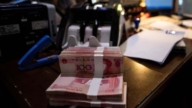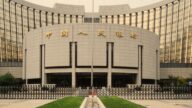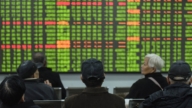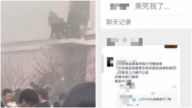【新唐人2013年09月09日讯】最近几年,中国各银行一直在大规模扩张信贷,用以刺激经济增长和保持银行业的高利润。但随着中国经济增速的减缓,大陆银行业越来越严重的“坏帐”危机日益凸显出来。外界分析,中共在坏账处理上已经陷入困局,很可能会再次增发货币,将坏账转嫁到普通百姓身上。
最近,中国四大银行发布报告声称,他们的上半年总盈利增长约12%。而上个月,中国银行协会曾预测,中国17家上市银行的净盈利增长将从2012年的19%放缓到2013年的8%。
四大银行的这一中期业绩虽然略高于此前外界的预测,但丝毫无助于减少人们对中国银行业充满高风险的担忧。
今年以来,上海上市银行的股价指数下跌达9.1%,比上证综合指数下跌7.6%的表现还差。而且,目前中国银行股票是亚太地区最廉价的,在全球也位居第三最廉价,它的12个月前瞻市盈率为4.8,仅好于阿根廷和巴林。
英国《金融时报》中文网报导,自从2008年全球金融危机以来,中共当局出台了一项大规模经济刺激计划,中国的信贷总量增长超过一倍。
国际著名评估机构高盛(Goldman Sachs)和摩根士丹利(Morgan Stanley)的分析师指出,如果算上银行信贷、影子银行系统融资、债券市场以及政府债务,中国的未清偿信贷总额与GDP之比已经高达220%。
在剔除中央政府的直接借款之后,未清偿信贷仍然达到了105万亿人民币。如果按照中国在二十世纪九十年代末期20%的不良贷款率估算,这意味着坏账规模达到21万亿人民币,与GDP之比达40%。但当局公布的银行不良贷款率甚至不足1%,只有大约5400亿人民币。这个数据完全忽略了影子银行的存在,而中国不良贷款的真实状况或许就埋在影子银行这条巨大的暗沟之中。
北京师范大学MBA导师、经济专栏作家段绍译:“国有银行的钱,也都是贷给了国有企业,等于是左手贷给右手。也就是说,一些企业还不起银行贷款的时候,它并不会让这个企业破产,还是把这笔坏账一直挂着。”
《金融时报》报导说,关于中国银行业,有两个广受认同的观点。第一,中国银行业的坏账规模将使2008年的美国银行业危机相形见绌。第二,中共当局处理坏账问题的方式与其他政府不同。
上世纪九十年代末期,中国就曾通过一轮所谓的循环融资将四大国有银行的大部分坏账剥离出来,注入四家专门成立的所谓“资产管理公司”。
美国南卡罗莱纳大学“艾肯商学院”教授谢田:“中共耍了一种手段,它用剥离的办法把那些坏账给剥离出来。把那些坏账打包以后,兜售给了其他一些西方金融机构。华尔街这些金融公司实际上为中共输血,帮助中共度过这个难关。”
美国南卡罗莱纳大学“艾肯商学院”教授谢田表示,现在中国银行业的坏账问题又更大范围的出现,而华尔街的金融公司自身也处境不佳,中共将很难重施故技。
谢田:“如果银行坏账的问题跟中国地方政府的地方债问题、还有房地产泡破问题,这些都连在一起,它们实际上本身也是联系在一起的。如果这些都连在一起爆发的话,那就会拖垮中国的金融体系和那些国有银行。”
谢田强调,这样的情况下,中共一定会通过增发货币来试图化解危机,而这将直接促成通货膨胀,也就是相当于:把坏账的负担再一次转嫁到老百姓身上。
采访/陈汉 编辑/李谦 后制/李智远
More Money Printing Expected In China
In recent years, bank loans have continued to grow in China.
The Chinese Communist Party (CCP) has used it to boost
the economy and to maintain high bank industry profits.
In reality, China’s economy has slowed down,
and the banking sector has seen increasing debt.
Analysts say that the CCP has run out of
solutions to the banks’ bad debt problems.
They estimate that the regime might once again print
more money, to shift the burden to the Chinese people.
Recently, China’s big four banks released a report.
It claims that net income in the first half
of 2013 has increased by some 12%.
In July, the China Banking Association
predicted that net profit of China’s 17 listed
banks will go down to 8% from 19% in 2012.
The four banks’ interim performance
is slightly higher than previous forecasts.
Yet, it does not help ease public concerns
about high risks in China’s banking industry.
Since the beginning of 2013, share prices for China’s listed
banks have lost 9.1% on the Shanghai Stock Exchange.
In contrast, the Shanghai Composite Index dropped 7.6%.
Currently, China’s bank stocks traded at the lowest price
in the Asia-Pacific region, and third lowest in world rankings.
Reportedly, its forward price-to-earnings ratio for the next
12 months is 4.8, only higher than Argentina and Bahrain.
The UK’s Financial Times (FT) Chinese edition reports that,
Chinese authorities have announced a huge economic
stimulus plan, to cope with the 2008 global financial crisis.
The scheme has since doubled
China’s total amount of credit.
Analysts at Goldman Sachs and Morgan Stanley have
indicated China’s credit-to-GDP ratio has reached 220%.
The calculation takes into account bank credit, shadow
banking financing, bond markets and government debts.
Analysts said that excluding the central
authorities’ direct loans, China still has
105-Trillion Yuan of outstanding credit.
In the late 1990s, China’s non-
performing loan (NPL) ratio was 20%.
Using this figure, China has seen 21 Trillion Yuan
of bad debts, with bad debt-GDP ratio up to 40%.
In reality, China’s officially released bank NPL
ratio is below 1%, around 540 Billion Yuan.
FT says that China’s truth of bad loans may be
hidden by the unveiled giant shadow banking.
Duan Shaoyi, Economist: “State-owned commercial banks
have mainly loaned money to state-owned enterprises.
It’s like a loan transferred from the left hand to the right hand.
So, when some SOEs have defaulted
loans, the banks won’t let them go bankrupt.
The banks usually just write it off as bad debts.”
FT points out two widely accepted
views on China’s banking sector:
The size of bad debt dwarfs
America’s banking crisis in 2008.
Chinese authorities’ way of dealing with the
banks bad debts differs from other governments.
In the late 1990s, the CCP authorities wrote
off bad assets of the big four state-run banks.
The value was recorded as investment injected into four
specifically established “Assets Management Companies”.
Xie Tian, Professor at University of South Carolina-Aiken:
“The CCP used a trick to write off those bad debts.
It wrapped up the bad debts and sold
them to some Western financial institutions.
These Wall Street financiers have actually injected the
CCP with blood, and helped it to overcome the crisis.”
Xie Tian says that bad debt has
grown in China’s banking system.
Meanwhile, Wall Street financial institutions are ailing.
So, it is hard for the CCP to play the same trick again.
Xie Tian: “Chinese banks’ bad debt problems are connected
with issues of local government debt and real estate bubbles.
Once they break out all together, China’s financial
system and state-owned banks will collapse.”
Xie Tian forecasts that the CCP will increase
currency assurance to defuse the crisis.
This will directly lead to inflation, he warns.
In other words, bad debt burdens will
again pass on to ordinary Chinese citizens.

























